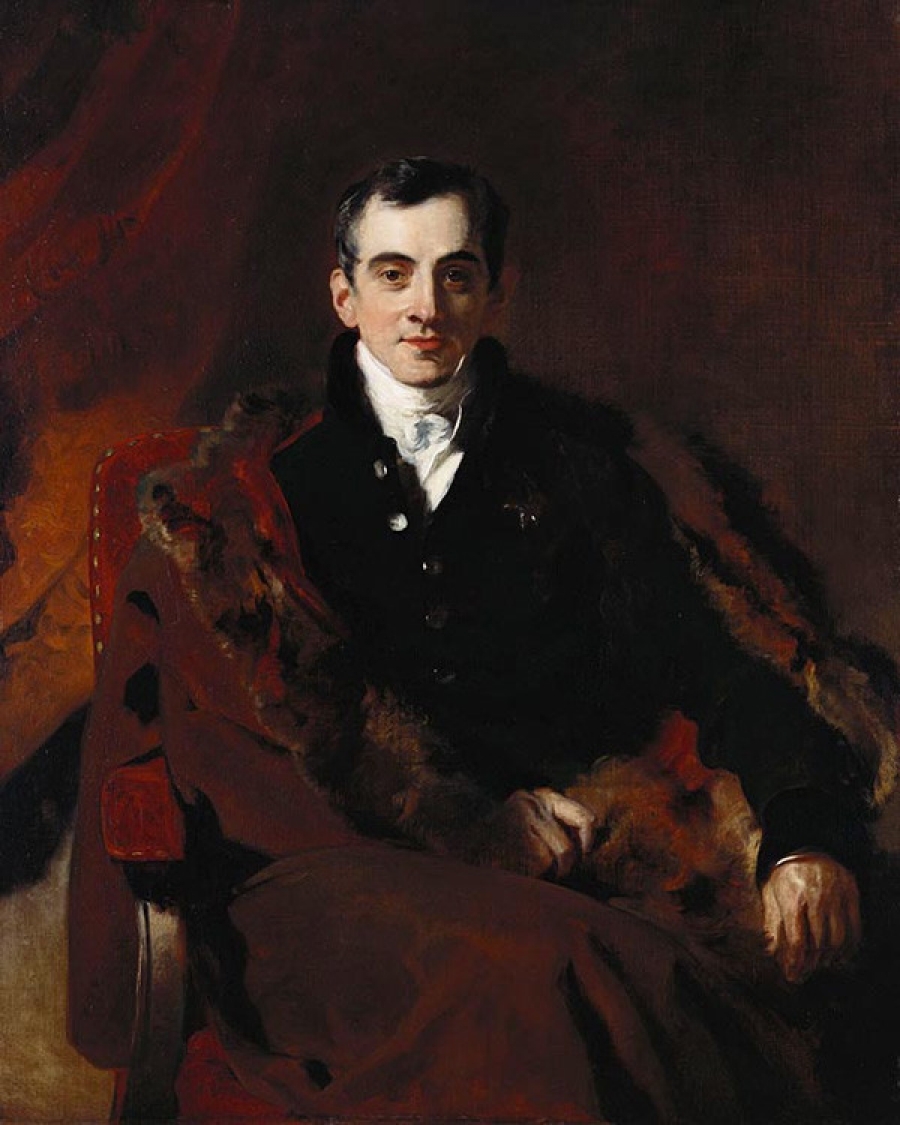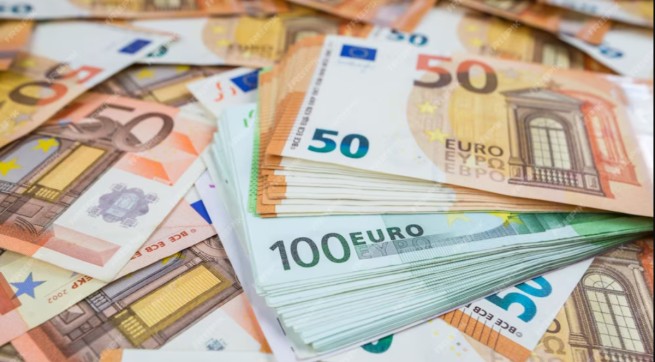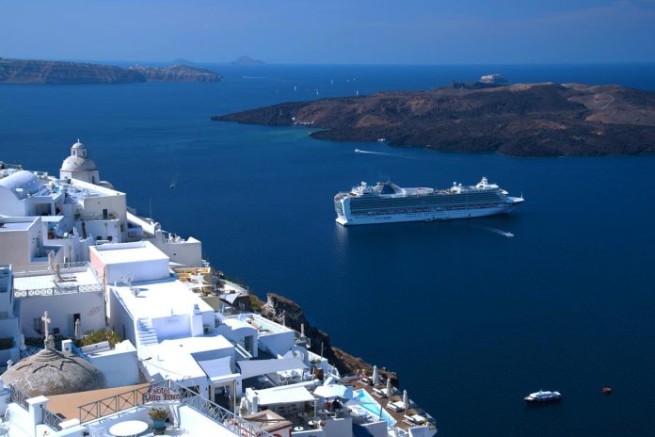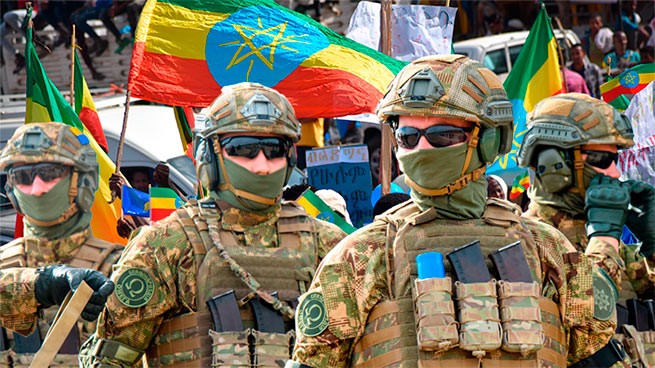On September 27, 1831, Ioannis Kapodistrias, the first president of independent Greece, was assassinated in Nafplio. His assassination weakened the country, depriving it of the opportunity to become a modern state of that time.
His policy was pro-Russian, for this the first president of independent Greece, John Kapodistrias, was killed in a cleverly arranged dump near the church of St. Spyridon by the sons of Petrobeus Mavromichali, political opponents from the pro-Turkish camp, behind which were the British. The case of his murder is still one of the most secret in the British public archives. The death of John Kapodistrias caused a wide public outcry and was reflected in painting.
Dionysius Tsokos. The murder of John Kapodistrias, 1850. Oil on canvas. Trieste
Konstantin Mavromikhali was packed with people on the spot, and George managed to hide in the house of the French mission, but was extradited and executed. For the murder of Kapodistrias, the people’s assembly imposed an anathema on the entire family of Mavromikhali.

Dionysius Tsokos. Assassination of John Kapodistrias, 1850. Oil on canvas, Benaki Museum
Count Kapodistrias was first buried in Nafplion, the first capital of independent Greece. However, six months later, his brother Augustine, according to John’s will, moved the body of the ruler to Corfu and buried it on the outskirts of the island’s capital in the monastery of Platytera. Monuments of Kapodistrias are installed in Athens, Nafplion, St. Petersburg, Lausanne, Aegina, and also on the island of Corfu. The airport in Corfu is named after him, and finally, his portrait is minted on a coin of 20 euro cents.
 The monument to Count Ioannis Kapodistrias in Nafplion was created in 1932 by sculptor Mihail Tombrosa. The square on which the monument is erected also bears the name of Kapodistrias.
The monument to Count Ioannis Kapodistrias in Nafplion was created in 1932 by sculptor Mihail Tombrosa. The square on which the monument is erected also bears the name of Kapodistrias.
 The monument to John Kapodistrias, the first President of the Hellenic Republic and Secretary of State for Foreign Affairs of Emperor Alexander I (sculptor V.M. Klykov, architect M.A. Reinberg) was opened in St. Petersburg in May 2003.
The monument to John Kapodistrias, the first President of the Hellenic Republic and Secretary of State for Foreign Affairs of Emperor Alexander I (sculptor V.M. Klykov, architect M.A. Reinberg) was opened in St. Petersburg in May 2003.
 On September 22, 2009, a monument to John Kapodistrias was installed in one of the most beautiful places in Lausanne, on the Usha embankment. The author of the sculpture was the Russian sculptor Vladimir Suvortsev.
On September 22, 2009, a monument to John Kapodistrias was installed in one of the most beautiful places in Lausanne, on the Usha embankment. The author of the sculpture was the Russian sculptor Vladimir Suvortsev.
There is an opinion that if it were not for the assassination of Kapodistrias, then his far-sighted and bold policy could greatly influence the further development of the world. Kapodistrias was ahead of his time in many ways, he thought in terms of a united Europe, assigning a worthy place to Russia in it. He defended the need for adherence to the legal foundations in international relations, opposed unilateral interference in the internal affairs of other states. In an effort to ensure stability, I. Kapodistria proposed the idea of creating an organization that anticipated the United Nations. It can be argued that he was one of the ideologists of the peaceful structure of the European continent.

The portrait by the famous English portrait painter Thomas Lawrence (1769-1830) depicts Count John Kapodistrias (1776-1831), Russian Foreign Minister (1816-1822) and the first ruler of independent Greece (1827-1831). Ironically, this portrait is kept in the royal collection of England – a country that was on many issues his political opponent.
In the Russian public service, including the diplomatic one, there were a total of about 150 diplomats of Greek origin, in the rank of ambassador or envoy. The most striking and famous example is John Kapodistrias. For worthy service for the good of the Russian Empire, he was awarded the Order of the Apostle Andrew the First-Called, the highest Russian award until 1917.

Count John Kapodistrias (1776-1831). National Historical Museum, Athens.
John Kapodistrias was born on January 31, 1776 into an aristocratic Greek family on the island of Corfu. After graduating from the course of philosophy and medicine at the University of Padua, he entered the diplomatic service in his homeland. During the years of the struggle of Greece for freedom and the war with Turkey, he participated in the creation of the “Republic of the Seven Islands” in the Ionian Islands, which was under the auspices of Russia. According to the Treaty of Tilsit (1807), Russian control of the islands passed to the French. For a further career, Kapodistrias entered the Russian service and was added to the College of Foreign Affairs (1809). Two years later, he was appointed secretary of the Russian embassy in Vienna, then he conducted diplomatic correspondence with P.V. Chichagov, a statesman and military leader. He was also entrusted with the task of developing a project for the arrangement of Bessarabia, which had just been annexed to Russia.
In 1813, Kapodistrias accompanied Emperor Alexander I as head of the Chancellery, and then was sent to Switzerland with instructions to bring her into an alliance against Napoleon. Sending a diplomat to Switzerland, Alexander I gave him the following recommendations: “Kapodistrias is a very worthy person in terms of his honesty, gentleness of treatment, in terms of his knowledge and liberal views. He comes from Corfu, therefore, a republican, and my choice was on him precisely because I know the principles by which he is guided.”

Kapodistrias participated in the signing of the treaty at the Congress of Vienna in 1815, where he spoke in favor of Switzerland, participated in the drafting of the Swiss constitution, and also contributed to the canton of Vaud being recognized as a full member of the Swiss Confederation. In gratitude, in 1816, the municipality of Lausanne offered to give “His Excellency Monsieur Jean, Count of Capo d’Istria (as the name of the diplomat was written in French), honorary citizenship, as a feeble testimony of the gratitude that we all express to him.”
In addition to Emperor Alexander I, the participants in the Congress of Vienna were: Maximilian I – King of Bavaria; Franz I – Emperor of Austria; Louis XVII – King of France; Friedrich Wilhelm III – King of Prussia; George IV – Prince Regent of England. The successful execution of the commission, as well as the brilliant talents discovered at the Congress of Vienna, provided him with a quick promotion. In 1815, he was granted the title of secretary of state, and from 1816 he was the manager of the Collegium of Foreign Affairs under the Minister of Foreign Affairs K.V. Nesselrode (1816-1856). Thus there were, as it were, two ministers of foreign affairs, whose views on the tasks of Russian foreign policy diverged considerably. The emperor served as an intermediary between them, leaning much more towards Nesselrode.

Thomas Lawrence. Carl Nesselrode, 1818. Collection of the Royal Palace of Windsor, London
The role of Kapodistria in the fate of the young Pushkin, who served under him in the Collegium of Foreign Affairs, is important. Thanks to the intercession and intercession of Kapodistrias before Tsar Alexander, the exile to Siberia that threatened Pushkin was replaced by a transfer to Bessarabia. Kapodistrias sent Pushkin to Chisinau, that is, to the very center of the Greek revolutionary movement, where a commission of jurists sent by Kapodistrias, under the supervision of General and Freemason I.N. Inzov, created a code of Bessarabian laws. Subsequently, these laws became the laws of independent Greece under the ruler of Kapodistrias. This man was dear to Pushkin, and he painted him several times in the margins of his manuscripts.

John Kapodistrias. Pushkin’s drawing on the draft of the manuscript “Ruslan and Lyudmila”
Drawings by Alexander Sergeevich Pushkin reveal another page in the biography of Count Kapodistrias. So, three of his portraits are located next to the portrait of Roxandra Sturdza-Edling (1786-1844). The beloved maid of honor of the Empress Elizabeth Alekseevna was a longtime acquaintance of the poet.
Roxandra Sturdza met John Kapodistrias in the house of Admiral Pavel Vasilyevich Chichagov. In the person of Roxandra, Kapodistrias found an ardent supporter of the cause of the liberation of the Greeks. She turned out to be an excellent conversationalist: a brilliant education received at home, a penetrating mind allowed her to keep up conversations on almost any topic – from philosophical and religious to political. Emperor Alexander I often and for a long time talked with Roxandra, visiting his wife.
It is believed that Kapodistrias was the fiancé of Roxandra, but he was embarrassed by the attention of Emperor Alexander I to her. During one of his meetings, Kapodistrias handed Roxandra a ring depicting a butterfly burning on fire. She understood this as a hint of a change in their relationship, as a refusal of the offer, and in return for her former love, she promised friendship to Kapodistrias. “Count Kapodistrias,” Roxandra Edling wrote, “belonged to the number of people whose acquaintance is an era in life … His beautiful appearance is marked by the seal of a genius …”.

Roxandra Skarlatovna Edling-Sturdza, lithograph from the collection of Prince A. Gagarin
In 1822, due to disagreements with Alexander I on foreign policy issues, Kapodistria left Russia, again leaving for Switzerland. Living abroad, he willingly helped visiting Russians, about which Batyushkov wrote enthusiastically to his aunt in Russia. In Switzerland, Kapodistrias studied history and wrote a lot to Russian friends, scientists and writers.
Kapodistrias gave all his energy in the diplomatic service for the benefit of the Russian Empire, but his soul always belonged to Greece. He sympathized with the revolution that began in March 1821 in Greece, but twice rejected the offer of the secret society of Greek rebels “Filiki Eteria” to become the head of the country, remaining a spectator of the struggle for a long time, supporting the rebels with money and intercession at European courts.

On April 11, 1827, Count I. Kapodistrias was elected ruler of Greece by the people’s assembly in Troezen for 7 years. This position was similar to the presidential one. The new president waited out the Battle of Navarino (a naval battle between the united squadron of Russia, England and France on the one hand and the Turkish-Egyptian fleet on the other), which ensured the freedom of Greece, and only on January 18, 1828, he arrived in the country entrusted to him. When negotiations began between the powers on the choice of the king of Greece, Kapodistrias, in official and private letters, insisted that the opinion of the people be taken into account, which was expressed in such cases through the lips of members of the popular assemblies, selected by the president. The Republican wanted to get the Greek crown, because he understood that the local rebels and their cruel leaders, hardened in guerrilla warfare with the Turks and internecine strife, would appreciate only strong monarchical power. Not without influence from Kapodistrias, Prince Leopold of Saxe-Coburg (later King of Belgium) refused the crown offered to him.

Nafplio from the time of Ioannis Kapodistrias







More Stories
Metropolitan Chrysostom: "The Church will never recognize same-sex marriage – the issue is not closed"
Schools in Germany: convert to Islam so as not to be an outsider
On this day in 1896, a statue was found in Delphi "Delphic Charioteer"